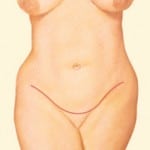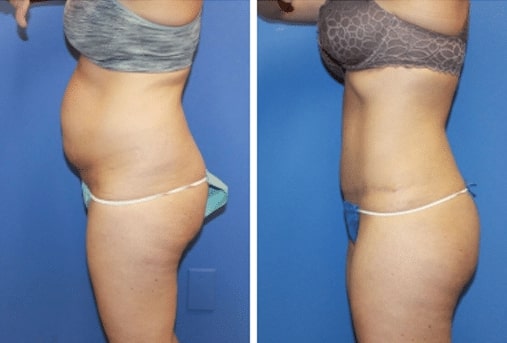Table of Contents:
- What Is A Tummy Tuck?
- What Results Can I Expect with a Tummy Tuck?
- How Is A Tummy Tuck Performed?
- How Soon after my Tummy Tuck Surgery Will I See my Results?
- What Should I Expect After A Tummy Tuck?
- What Is Recovery Like After A Tummy Tuck?
- How Soon Can I Return to Normal Activity After A Tummy Tuck?
- Do I Need A Full Abdominoplasty Or Mini-Abdominoplasty?
- How Do I Know If I Need Liposuction Or An Abdominoplasty?
- How Much Does A Tummy Tuck Cost?
- How Is Diastasis Recti Treated With A Tummy Tuck?
- Can An Abdominoplasty Be Done Without General Anesthesia?
- Can Liposuction Be Done At The Same Time As An Abdominoplasty?
- Can A Tummy Tuck Be Drain-Free?
- Should I Wait To Have Surgery Until I Am Done Having Children?
- Can Diastasis Recti Be Repaired Without Tummy Tuck?
- Will My Tummy Tuck Look Natural?
- Can I Get A Six-Pack With A Tummy Tuck?
- How Safe Is The Tummy Tuck Procedure?
What is a Tummy Tuck?
Tummy Tuck, also referred to as an abdominoplasty, is Dr. Yates's favorite operation. Patients love the way it looks, love the way it makes them feel, and Dr. Yates feels pride and satisfaction in getting them there.
Abdominal stretching associated with childbirth and weight fluctuations can cause loose skin, stretch marks, and separation of abdominal muscles (diastasis). Tummy tuck surgery (abdominoplasty) removes excess abdominal skin while tightening and flattening the abdomen. This is performed using a “bikini line” incision in the lower abdomen. The abdominal muscles are tightened as indicated. Depending upon the degree and location of skin excess and stretch marks, the patient may benefit from a full abdominoplasty or mini-abdominoplasty.
Tummy Tuck Before & After
What Results Can I Expect with a Tummy Tuck?
With these procedures, Dr. Yates tightens loose, sagging skin from the belly button down to the upper pubic area. Through the upper incision around the navel, he can also tighten some of the skin above the belly button.
In most cases where Dr. Yates feels a full or extended tummy tuck is needed, the patient’s rectus abdominis muscles have become separated by the highly localized weight gain with pregnancy. There isn’t any way a person can get these muscles back to the center of the stomach where they provide support without surgery. Dr. Yates brings these muscles back to the center and sutures them together in their former location.
Pockets of fat are also usually removed with targeted liposuction. The belly button is usually moved to a higher position.
Bottom line? A tummy tuck with Dr. Yates will flatten your abdomen, firm the entire tummy area, reduce unwanted pockets of fat, and possibly even slim your waist. These results are very satisfying.
How is a Tummy Tuck performed?
Every patient is different, and the exact procedure is tailored to the patient and their goals. The steps of the operation include:
- a low abdominal incision (well hidden)
- elevation of the skin and fat as a unit to approximately the ribs
- muscle repair to flatten and tighten the abdomen
- removal of the excess skin and fat with the patient in a sitting position
- meticulous creation of a new pretty belly button
- closure with internal dissolving sutures to prevent suture marks
- for a drainless tummy tuck, the skin and fat will be secured to the abdominal wall with progressive tension sutures. Deep suture placement helps prevent pockets that can develop where fluid usually accumulates, freeing you from the need for drains to manage fluid.



If you are interested in a tummy tuck, contact Dr. Yates today to schedule a consultation. Dr. Yates treats patients in Salt Lake City, Layton, and nearby areas.
How Soon after my Tummy Tuck Surgery Will I See my Results?
You’ll see a dramatic difference immediately, but there will be bandages and swelling to mask things. You’ll also be wearing compression garments for about one month to help your body adapt to its new slimmer contour. Still, you’ll see a big difference immediately and the results will look better and better as you recover.
What should I expect after Tummy Tuck Surgery?
After a full tummy tuck, you will remain in a slightly flexed position at the waist for a week to limit tension on the suture line. Pain medications are used as necessary for the first day or two. Lifting is limited, and a supportive garment (which is supplied) is used for 1-3 weeks. When used, drains are cared for until they are removed, usually at one week.
You will notice quite a difference early after your surgery, although some swelling will be present for up to one year. The scar will fade over the first year. The benefit will last forever unless there is a significant change in weight or pregnancy.
What Is Recovery Like after a Tummy Tuck?
This recovery isn’t a piece of cake, due to the lengths of the incisions and moving and repairing the abdominal muscles. There will be some pain, but the amount varies by the individual. You’ll be encouraged to walk after your surgery and should take a short walk three or four times a day for just a few minutes each time. You’ll have to walk a little hunched over and the skin of your abdomen may feel tight. If you have drains, they will be removed anywhere from four days to two weeks after your surgery. You’ll wear a compression garment to help your skin adapt to its new slimmer contour and to help with swelling.
It's important to be patient with abdominoplasty. Dr. Yates stresses this throughout your consultation and follow-up. This is no time to “push” things or to get back to exercise and other activities before we green light you. Doing so can create problems with the long lower incision, as it can impact healing. You need to lay low after this procedure and bring in reinforcements for help around the house. You’re on the bench for a while!

How Soon Can I Return to Normal Activity after a Tummy Tuck?
You’ll be able to walk after your surgery (it’s important to get the healing process started), but this is only for short lengths, and you’ll be bent over a bit (as mentioned above). In a couple weeks, you’ll be able to get back to work if you have a desk job, and you’ll be able to walk normally by then. Most patients can return to driving in two weeks or so. Dr. Yates will discuss your individual goals for returning to normal activities and exercise. Don’t expect to return to strenuous exercise or any lifting for at least six weeks, however.
Do I need a Full Abdominoplasty or Mini-Abdominoplasty?
At the time of your consultation, Dr. Yates will help you determine which would be best for you. Generally, a mini-tummy tuck improves the lower abdomen, whereas a full tummy tuck improves the entire abdomen. A “new” belly button is created with a full, whereas the original belly button remains after a mini. Dr. Yates pays particular attention to the appearance of the belly button as both he and his patients find this is very important.

More skin and stretch marks are removed with a full abdominoplasty than a mini abdominoplasty. The skin typically removed from a full tummy tuck is from the pubic hairline to the umbilicus. The typical skin removed from a mini tummy tuck is from the hairline to halfway to the umbilicus.
Diastasis Recti (DR) is better treated with a full abdominoplasty as there is improved access to the upper muscle for a strong repair. There are mini tummy tuck modifications that also allow full muscle repair in some patients.
Mini Tummy Tuck
- shorter scar
- less cost
- less risk
- lower skin removal only
- lower abdomen muscle tightening only
- Minimal change to the umbilicus
Full Tummy Tuck
- full muscle repair
- full skin tightening
- new umbilical shape if necessary
- longer scar
- more risk
- tougher recovery
How do I know if I need Liposuction or an Abdominoplasty?
Liposuction is a fat reduction procedure, whereas a abdominoplasty addresses underlying muscle shape, skin excess AND fat excess. The best candidates for liposuction have excess fat (but not too much) and good skin elasticity.

How much does a Tummy Tuck cost?
The cost of a tummy tuck can be separated into facility/ hospital fees, anesthesia fees, and surgeons’ fees. The cost is generally greater with more experiences surgeons than those just starting out. We are transparent about our fees.
How is Diastasis Recti treated with a Tummy Tuck?
Tummy tuck surgery is well designed to improve both the aesthetics and function of the abdomen. Women with separation of their abdominus recti muscles after pregnancy have what is clinically referred to as Diastasis Recti (DR). For many of our patients, this is their primary concern.

Repair of diastasis is an important part of any expertly performed abdominoplasty. Muscle repair occurs after the skin and fat have been delicately elevated to provide access and repair.
The degree of muscle separation is confirmed and repaired with sutures. There are many suture options when repairing the muscle and the patient would be well advised to simply put this choice into the hands of their chosen surgeon.
Our preferred technique is a combination of a few permanent sutures to line-up the repair followed by a long-lasting dissolvable suture. Patients report improved core strength and function after DR repair. A side benefit, a tummy tuck looks great.
Rectus diastasis is different than a hernia, and patients often confuse the two. A rectus diastasis involves stretched abdominal wall, muscle and fascia yet this tissue layer is still intact. A hernia involves a defect within the abdominal wall fascia that allows contents within the abdominal cavity to protrude outward. Often, small hernias are found incidentally at the time of abdominoplasty. A hernia should be repaired when encountered. This involves closure of the hernia defect which can often be reinforced with mesh or the body's own abdominal wall tissues at the time of diastasis rectus repair.

Can an Abdominoplasty be done without general anesthesia?
A full abdominoplasty can undoubtedly be done without general anesthesia. For appropriately selected patients, this is our preference.
- Lower risk of major complications such as DVT or pulmonary embolism
- Less postoperative nausea and vomiting
- Less early postoperative pain
Dr. Yates requires the patient to be of good health and near their ideal body weight to be a candidate for a full abdominoplasty in the office operating room. Dr. Yates operates only in fully accredited facilities.

Can Liposuction be done at the same time as an Abdominoplasty?
Dr. Yates will frequently do liposuction in combination with an abdominoplasty, most commonly on the abdomen and upper hips. There are varying opinions among plastic surgeons regarding multiple area large volumes of liposuction at the time of the tummy tuck.
There is an increased risk of DVT and pulmonary embolism when large volume liposuction is combined with an abdominoplasty. This is a major complication that can result in death, although rarely. Plastic surgeons have different appetites for risk. Dr. Yates feels that risks in cosmetic surgery should be reduced as much as possible. For that reason, Dr. Yates does not generally offer large volume liposuction at the time of a abdominoplasty.
Can a Tummy Tuck be drain-free?
It is possible to do abdominoplasty without a drain. There are a few technical modifications that decrease the risk of fluid accumulation (seroma) after the procedure. The most important modification is the use of either TissuGlu or progressive tension sutures. These modifications essentially close the dead-space that exists after the elevation of the abdomen skin and fat. Sealing this space with adhesive (TissueGlu) or sutures reduces the risk of fluid accumulation and drains can often be eliminated.
Update: As of 2019, TissuGlu is no longer manufactured. The only current effective method of drainless tummy tucks is progressive tension sutures. This works very well and in our practice, we have noticed a dramatic decrease in seroma rates with this advanced technique.
Should I wait to have surgery until I am done having children?
Generally, yes. Some of the benefits of a tummy tuck can be lost with the stretching of the abdomen associated with pregnancy. Often a tummy tuck is addressed at the time of a mommy makeover.
Can Diastasis Recti be repaired without Tummy Tuck?
The most consistent, dramatic improvement of diastasis recti is with a full tummy tuck. There is a laparoscopic DR repair that has been developed, however, because there is no skin removed, it can create skin deformity as the skin follows the muscle repair and can create a skin ridge for some patients. This type of repair is generally not offered by Plastic Surgeons.
Some patients don’t have enough skin excess to make a full tummy tuck worth the scar. For these patients, Emsculpt is a non-surgical procedure that has been shown to reduce muscle separation without surgery. The degree of improvement in muscle separation is much less than surgical repair, however.
Will My Tummy Tuck Look Natural?
The sagging, loose skin that has developed on your lower abdomen is really what looks “unnatural” when you get right down to it. When we’re young, our abdomen is taut and firm. That doesn’t have to change with aging. Pregnancy and localized weight gain, however, can create this type of sagging. By removing the excess, sagging skin, Dr. Yates simply returns your tummy to the way it used to look. There’s nothing unnatural about that.
Can I get a six-pack with a Tummy Tuck?
Abdominoplasty surgery removes excess skin and fat but the definition of a six-pack is created by muscle definition. For patients who want a little help with building the core abdominal muscles, Emsculpt is a non-surgical procedure that has been shown to increase muscle bulk, tone, and definition. This can be done in combination with a tummy tuck.
How Safe Is the Tummy Tuck Procedure?
Dr. Yates will thoroughly discuss the rare but potential risks at the time of your consultation. There are risks inherent with any surgical procedure, and abdominoplasty is major surgery. Tummy tuck surgery has a higher risk of major complications than other types of cosmetic surgery, a 4 percent risk versus 1.4 percent with other types of cosmetic surgery. The most common complications shown in research were hematomas, infections, blood clots, and lung-related problems. These are still quite rare with healthy patients.
The risk of poor healing is much higher in smokers and patients with large upper abdominal scars from previous surgery. Dr. Yates requires patients to refrain from smoking for six weeks in preparation for surgery.
Really the biggest risk with abdominoplasty is the healing of the long lower incision. Much of the risk here, however, involves the patient following recovery instructions to the letter. Lifting too much weight too soon or placing undue stress on your incision can lead to uneven healing.
That’s just another reason to trust this procedure to only a board-certified plastic surgeon such as Dr. Yates. He is certified by the American Board of Plastic Surgery. He also has the extensive experience you can trust to vastly decrease any risk involved with this surgery, and to enjoy the results you hoped for.
Testimonials
“I was pretty nervous trying to find the right surgeon to perform my tummy tuck and was doing a lot of research online. I found Dr. Yates and after talking with the staff at the clinic I felt very confident that he was the right choice. They were very helpful with everything I needed as I was coming from out of town. I had my second baby and wanted to get rid of stretch marks and loose skin. The results are amazing and I was so happy that I decided to return about six months later to have my breasts re-done as well. I am just as pleased with the results from that operation and have already recommended him to friends.”
- KH from Michigan
Schedule Your Tummy Tuck Consultation Today!
To inquire about abdominoplasty or to schedule an appointment with Dr. Yates, please call 801.525.8741 or submit an online contact form. We also offer secure, private, online virtual consultations.


